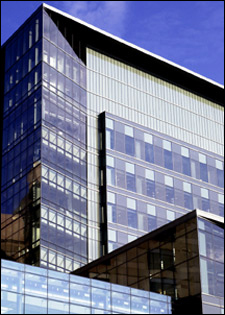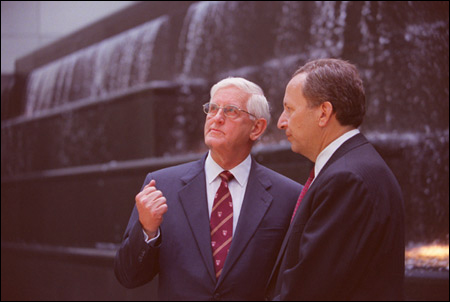New medical research building dedicated
The largest in Harvard history

The largest building ever built by Harvard was dedicated Sept. 24. University President Lawrence H. Summers and Joseph Martin, dean of the Medical School, cut a crimson ribbon at the entrance of the 525,000-square-foot New Research Building at 77 Avenue Louis Pasteur in Boston.
The glass walls of the $260 million structure reflected a bright blue sky and puffs of fair-weather clouds as a crowd of about 500 people witnessed the historic event.
Symposium information, www.hms.harvard.edu/milestone/index.html
Martin thanked planners, designers, engineers, contractors, and all the other people who contributed to making possible the magnificent building with the plain-vanilla name.
Summers pointed out that the New Research Building represents the largest expansion of the Medical School campus in the past 100 years. “In 1782, Harvard Medical School had a faculty of three, classes met in Harvard Yard, and there were no exams,” he noted. “Today, September 24, 2003, there are more than 8,500 faculty members, 17 affiliated teaching hospitals, and 25 different centers, divisions, and institutes.”
“It’s an exciting day and a spectacular and beautiful building,” he continued. “Many people in the United States will be far better off because of what will go on here.”
Inside the building, in its 500-seat auditorium, Martin welcomed guests to the first assembly there. He noted that the 800 people who will work in the labs and offices include researchers from both the Medical School and its affiliated hospitals, those who are making fundamental discoveries about human life and those who are using such discoveries to treat disease and injuries.
“The New Research Building represents a commitment to medical advancement through greater scientific collaboration,” Martin told the audience. “By having hospital-based and [Medical] School-based faculty working side by side in this new environment, biomedical opportunities will emerge and be taken more quickly from laboratory to bedside. Thus, this facility signifies the direction research is taking, and illustrates the obligation felt by us to end human suffering caused by disease.”
Finding the right balance
Summers talked about the future of life sciences at Harvard, and Sydney Brenner, from the Salk Institute for Biological Studies in California and co-winner of the 2002 Nobel Prize in Medicine, gave the first in a series of lectures that will be extended by monthly symposia until March 2004.

Facing a specialized audience, many of whom will work in the New Research Building, Summers remarked that he is constantly put in a position where “I must address people who know more about the subject than me.” He talked about the central role of the life sciences in human betterment in the past, present, and future. “We must find the right balance between basic science that helps us better understand life and practical science that can immediately improve health,” he said. “Today it is important for us to move from [laboratory] bench to bedside more rapidly than ever in the past.”
Summers then described other major initiatives at Harvard that would help reach this goal. The day before, the Medical School had announced establishment of a new department to study human biology in a more comprehensive way (see Web link provided). The Department of Systems Biology will take knowledge about genes and molecules and use it to predict how organs like the heart and lungs stay healthy or become diseased. Summers compared this effort to that of “bringing different parts of the University together for the purpose of finding new treatments for disease.”
The president also mentioned a new and ambitious collaboration between Harvard and the Massachusetts Institute of Technology called the Broad Institute, where researchers will take raw data generated by the Human Genome Project and turn it into new understanding and cures for human ills.
Summers also spoke about new methods of teaching, from the undergraduate to the M.D. level, being studied to help solve not just local but global health problems.
The New Research Building also boasts lounges, conference rooms, and other common spaces designed to increase communication and collegiality among specialists who normally don’t talk to each other much or at all. “We have invented so very much, we have discovered so very much at Harvard, I am convinced we can also discover how to collaborate across several-mile distances and I think we are making great progress,” Summers noted.
The president ended his talk on a personal note. “About 20 years ago, I was treated (at a Harvard facility) for a serious disease,” Summers recalled. “As you can see, it was successful. The treatment was a product of basic research that took place 10 to 15 years before. Many people may never know about this building decades from now, but there will be tens of thousands of them who will live longer lives of great joy because of it.”




